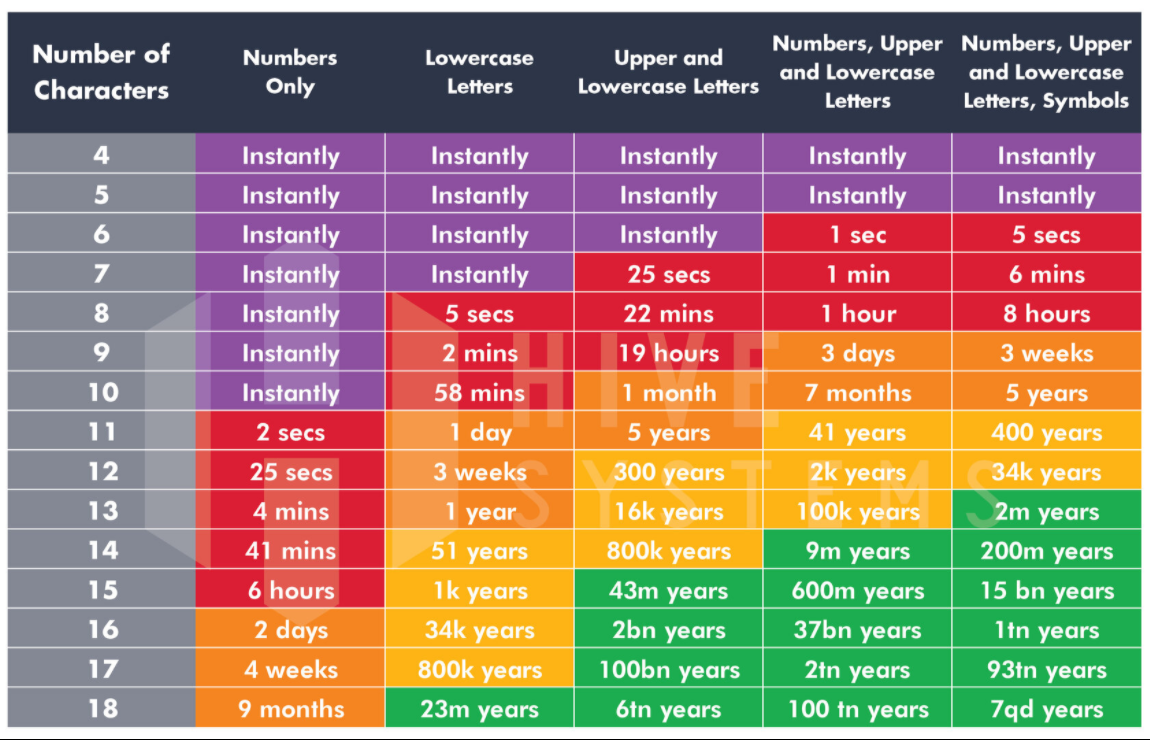Last updated: 05/15/2018
Author: Addictions.com Medical Review
And they need quite a few qubits to do anything useful. It's been estimated that 6,681 qubits would be required to run use Grover's algorithm to break AES-256 bit encryption. IBM's Q System gated quantum computer currently tops out at 20 qubits; it's been testing 50 qubit system. If a key is 40 bits long, how many keys must be tried, on average, to crack it? 2^(40)/2=549,755,813,888 How long must a symmetric encryption key be to be considered strong today? Triple DES encryption process It works by taking three 56-bit keys (K1, K2 and K3), and encrypting first with K1, decrypting next with K2 and encrypting a last time with K3. 3DES has two-key and three-key versions.
Reading Time: 2minutes
Crack is a crystallized form of cocaine which is made by processes that extract the cocaine oil base from the other variant chemicals used in the processing and distributions (to increase the weight) of cocaine powder. In effect, the typical potencies of crack can be 75% to 100% pure cocaine and as the hardened form is heated, it makes a crackling noise, hence, the term of “crack”.
There are several influential factors that determine how long crack stays in your system, but, for the most part, as dosages and frequencies increase, so will the metabolites of the drug take longer to eliminate.
Determining the Time It Takes to Eliminate Crack from Your System
The time it takes to eliminate crack from your system is the same as any comparable dosage of cocaine. Invariably, crack users often accelerate their use of the drug because the effects of crack are usually short-lived. Keep in mind that some forms of crack may be more potent than some forms of cocaine and because the ingestion is usually by smoking, more of the cocaine chemicals can enter your system. Repeat administrations add to its toxicity which can impair health and impact metabolism rates.
Other influential factors that may determine the time it takes to eliminate crack from your system are height and body weight, levels of activity, and health status. Hydration and the use of alcohol or caffeine can also play a role in eliminating crack from your system. Lots of water helps to flush toxins from the system, while caffeine and alcohol can cause delays.
How Long Does Crack Stay in Your System?
Most cocaine metabolizes within 4 hours, but, can still be detectable up to three months later in certain types of testing. The two major urinary metabolites of cocaine are benzoylecgonine (BE) and ecgonine methyl ester (EME). The major advantage of BE screening is that many commercial immunoassays are designed to detect BE.
How Long Does It Take To Crack 3des Free
For occasional users, the actual cocaine may only be detected for 12 hours in the urine, while metabolites specific to cocaine use can be present 4 to 5 days later. In chronic or heavy users, cocaine may be detected in the urine from 2-4 days, but, the elimination of metabolites is generally much longer and sometimes, up to 20 days.
Another metabolite that is created when alcohol is mixed with cocaine, is cocaethylene and this metabolite can be detected in urine for up to 25 days.
Other Testing Measures
Although urinalysis is the most frequently used testing for crack use, other measures are:
- Detection of crack in your blood is highly variable although it can be up to 48 hours.
- Saliva or sweat tests may only detect crack for up to 24 hours.
- Hair testing can show crack use for at least 90 days or until hair is cut or falls out.
In cryptography, the EFF DES cracker (nicknamed 'Deep Crack') is a machine built by the Electronic Frontier Foundation (EFF) in 1998, to perform a brute force search of the Data Encryption Standard (DES) cipher's key space – that is, to decrypt an encrypted message by trying every possible key. The aim in doing this was to prove that the key size of DES was not sufficient to be secure.
Background[edit]
DES uses a 56-bit key, meaning that there are 256 possible keys under which a message can be encrypted. This is exactly 72,057,594,037,927,936, or approximately 72 quadrillion possible keys. One of the major criticisms of DES, when proposed in 1975, was that the key size was too short. Martin Hellman and Whitfield Diffie of Stanford University estimated that a machine fast enough to test that many keys in a day would have cost about $20 million in 1976, an affordable sum to national intelligence agencies such as the US National Security Agency.[1] Subsequent advances in the price/performance of chips kept reducing that cost until, twenty years later, it became affordable for even a small nonprofit organization such as the EFF to mount a realistic attack.[2]

The DES challenges[edit]
DES was a federal standard, and the US government encouraged the use of DES for all non-classified data. RSA Security wished to demonstrate that DES's key length was not enough to ensure security, so they set up the DES Challenges in 1997, offering a monetary prize. The first DES Challenge was solved in 96 days by the DESCHALL Project led by Rocke Verser in Loveland, Colorado. RSA Security set up DES Challenge II-1, which was solved by distributed.net in 39 days in January and February 1998.[3]
In 1998, the EFF built Deep Crack (named in reference to IBM's Deep Blue chess computer) for less than $250,000.[4] In response to DES Challenge II-2, on July 15, 1998, Deep Crack decrypted a DES-encrypted message after only 56 hours of work, winning $10,000. The brute force attack showed that cracking DES was actually a very practical proposition. Most governments and large corporations could reasonably build a machine like Deep Crack.
Six months later, in response to RSA Security's DES Challenge III, and in collaboration with distributed.net, the EFF used Deep Crack to decrypt another DES-encrypted message, winning another $10,000. This time, the operation took less than a day – 22 hours and 15 minutes. The decryption was completed on January 19, 1999. In October of that year, DES was reaffirmed as a federal standard, but this time the standard recommended Triple DES.
The small key space of DES, and relatively high computational costs of Triple DES resulted in its replacement by AES as a Federal standard, effective May 26, 2002.
How Long Does It Take To Crack 3des 10
In many ways, such projects signaled that the hard cypherpunks minded way of thinking about applied cryptography had reached its peak.
Technology[edit]

Deep Crack was designed by Cryptography Research, Inc., Advanced Wireless Technologies, and the EFF. The principal designer was Paul Kocher, president of Cryptography Research. Advanced Wireless Technologies built 1856 custom ASIC DES chips (called Deep Crack or AWT-4500), housed on 29 circuit boards of 64 chips each. The boards were then fitted in six cabinets and mounted in a Sun-4/470 chassis.[5]
The search was coordinated by a single PC which assigned ranges of keys to the chips. The entire machine was capable of testing over 90 billion keys per second. It would take about 9 days to test every possible key at that rate. On average, the correct key would be found in half that time.
In 2006, another custom hardware attack machine was designed based on FPGAs. COPACOBANA (COst-optimized PArallel COdeBreaker) is able to crack DES at considerably lower cost.[6] This advantage is mainly due to progress in integrated circuit technology.
In July 2012, security researchers David Hulton and Moxie Marlinspike unveiled a cloud computing tool for breaking the MS-CHAPv2 protocol by recovering the protocol's DES encryption keys by brute force. This tool effectively allows members of the general public to recover a DES key from a known plaintext–ciphertext pair in about 24 hours.[7]
References[edit]
- ^'DES (Data Encryption Standard) Review at Stanford University – Recording and Transcript'. 1976. Archived from the original on May 3, 2012. Retrieved March 20, 2012.
- ^'DES Cracker Project'. EFF.org. Archived from the original on June 22, 2013. Retrieved October 9, 2013.
- ^David C. McNett (February 24, 1998). 'The secret message is...' distributed.net. Archived from the original on March 4, 2016. Retrieved February 27, 2014.
- ^'DES Cracker Project'. EFF. Archived from the original on May 7, 2017. Retrieved July 8, 2007.
On Wednesday, July 17, 1998 the EFF DES Cracker, which was built for less than $250,000, easily won RSA Laboratory's 'DES Challenge II' contest and a $10,000 cash prize.
- ^Electronic Frontier Foundation (1998). Cracking DES – Secrets of Encryption Research, Wiretap Politics & Chip Design. Oreilly & Associates Inc. ISBN1-56592-520-3.
- ^'COPACOBANA – Special-Purpose Hardware for Code-Breaking'. www.sciengines.com. Archived from the original on July 24, 2016. Retrieved April 26, 2018.
- ^'Divide and Conquer: Cracking MS-CHAPv2 with a 100% success rate'. CloudCracker.com. July 29, 2012. Archived from the original on March 16, 2016. Retrieved March 16, 2016.
External links[edit]

| Wikimedia Commons has media related to EFF DES cracker. |